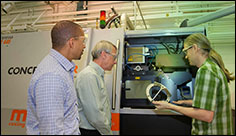Researchers outline physics of metal 3-D printing
15. 1. 2016 | Phys.org | www.phys.org
While the most common method of metal 3D printing is growing exponentially, moving forward from producing prototypes to manufacturing critical parts will be possible only by reaching a fundamental understanding of the complex physics behind the process, according to a new paper authored by Lawrence Livermore National Laboratory (LLNL) researchers.
The powder bed fusion process, also known as selective laser melting (SLM), requires thin layers of a metal powder to be spread across a build area, where they are fused by a laser or electron beam based on a 3D computer-aided design (CAD) model. The process is repeated until a part is produced, layer-by-layer from the bottom up.

Even though the method has quickly progressed into a production technology, 3D printing of metal parts (also known as metal additive manufacturing) for industries such as aerospace and health care is hampered, according to LLNL's Wayne King, by a lack of confidence in the finished parts. This hurdle, he said, can be overcome by a combination of physics-based modeling and high-performance computing to determine the optimal parameters for building each part.
Read more at Phys.org
Image Credit: Lawrence Livermore National Laboratory
-jk-




